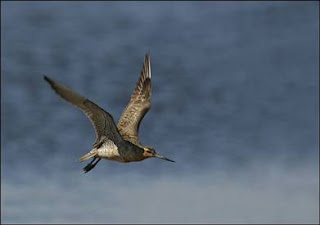
Forgoing layovers and snack stops, a bird known as the bar-tailed godwit has broken the record established for the world's longest known nonstop bird flight, according to a new study.
The honor goes to a female named "E7" that continuously flew 7,257 miles across the Pacific Ocean, breaking the previous record set by a Far-Eastern curlew, who flew 4,038 miles nonstop.
Bar-tailed godwits use forward flapping flight and seldom ever glide," lead author Robert Gill, Jr., told Discovery News.
Gill, project leader of the shorebird research program at the U.S. Geological Survey, explained that climbing midair while gliding is costly in terms of energy for birds, so continuous wing-flapping surprisingly saves on "fuel."
He and his team tracked multiple bar-tailed godwits as they flew from their summer breeding grounds in the western Alaska tundra to New Zealand, where they spend the rest of the year. Females were surgically implanted with transmitters, while males, which in this species are smaller and lighter, were affixed with external transmitters.
The migrating birds' flights lasted between five and 9.4 days.
The findings, published in the latest issue of Proceedings of The Royal Society B, suggest that oceans, mountain ranges, deserts, ice fields and other vast, open spaces may not always be barriers to migration, as had previously been thought. Instead, like a fast lane on a low-traffic highway, they might provide some animals with optimal, near hassle-free travel routes.
So long as weather events follow fairly predictable patterns, the Pacific Ocean appears to provide such a preferable route for the bar-tailed godwit, which must load itself with fuel in preparation for the long journey.
Before leaving Alaska in the early fall, the birds use their thin beaks to gorge themselves on food, such as tiny clams.
"Their bodies can consist of 55 percent fat at this time," said Gill, who added that the birds still have a streamlined, airplane-like shape despite their "boxy appearance" in the midsection just before take off.Both this study and prior work conducted by the team determined that the birds take advantage of low-pressure systems.
"Tailwinds give them a nice, free ride for several thousand kilometers," he said.
In flight, the birds also encounter few, if any, predators and avoid parasite infestations that can occur on land.
Flapping for over nine days, though, does take a toll.
Rob Schuckard, who helped document E7's flight last year and is a team leader at the Ornithological Society of New Zealand, said it's "like running for a week," with the human equivalent being a super-athlete who could somehow sprint without resting at 43.5 mph throughout a week-long haul.
The birds may even burn protein tissue in addition to stored body fat during the flight, which adults make yearly throughout their 15- to 20-year lifespan, Gill said.
Both he and Schuckard are concerned for the godwit's future, however. In the mid 1990s, around 155,000 birds were recorded as having made the north to south trip, but those numbers have dropped to around 70,000 in recent years.
Gill said habitat loss has hurt the birds. Climate change remains an unknown factor. If storm patterns shift, the godwits "could get a better tailwinds push off," but there's also a chance the changes could lead to greater headwinds, delaying the migration.
"A La Niña event in 2007 did just that by short-stopping the flight of some birds in Alaska," said Gill, who hopes future studies will reveal more about the possible impacts of climate change on bird migrations, as well as how this species' efficient metabolism works.
"Physiologists couldn't help but be interested in the extreme endur
© 2008 Discovery Channel
Tidak ada komentar:
Posting Komentar